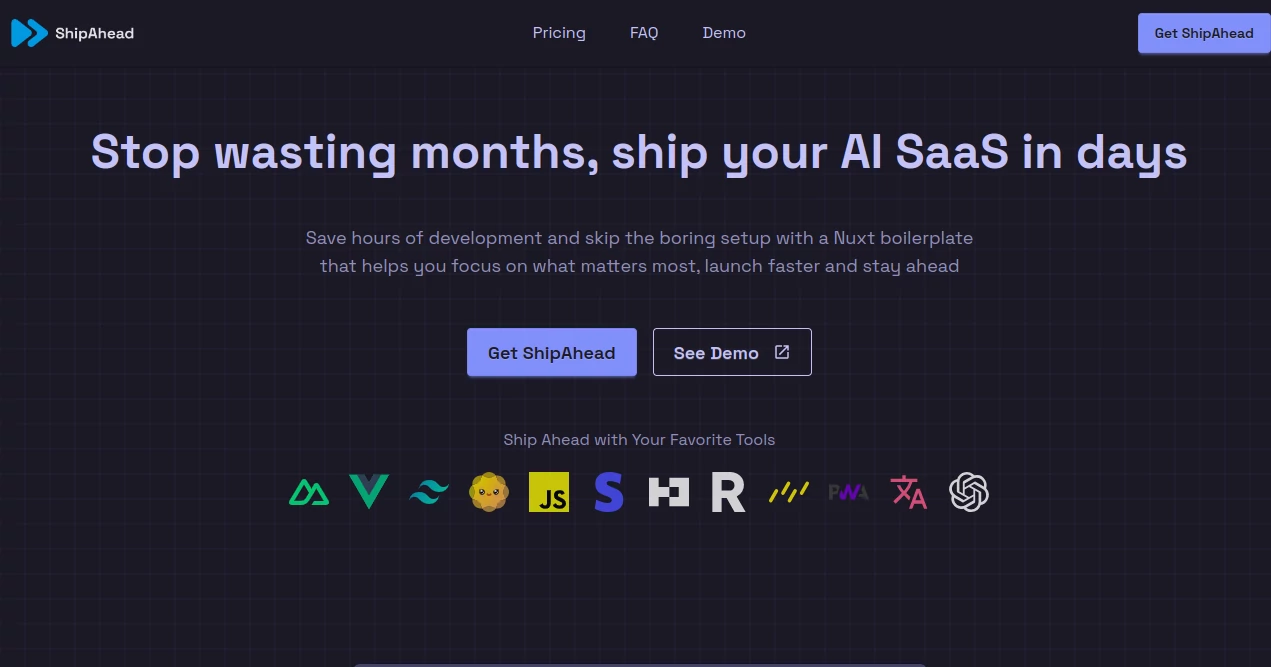🧠 AI Quiz
Think you really understand Artificial Intelligence?
Test yourself and see how well you know the world of AI.
Answer AI-related questions, compete with other users, and prove that
you’re among the best when it comes to AI knowledge.
Reach the top of our leaderboard.
ShipAhead
Launch AI SaaS Apps in Days, Not Months

What is ShipAhead?
ShipAhead hands developers a ready-made foundation for spinning up AI-driven services, cutting through the usual setup slog to let ideas hit the ground running. This boilerplate packs in the nuts and bolts so you can zero in on what makes your project shine, turning weeks of wiring into a quick afternoon tweak. Solo builders and small crews alike have turned to it, sharing stories of shipping their first live tools faster than they ever thought possible.
Introduction
ShipAhead grew out of the frustration many coders face when every new venture starts with the same old grind—piecing together logins, payments, and basics that eat up precious time. A team of devs who’d been there decided to bundle it all into one solid starter kit, tailored for those building subscription-based apps with a dash of smarts. Since dropping, it’s helped hundreds skip the boilerplate blues, with users raving about how it freed them to experiment and iterate without the drag. It’s that rare find: a shortcut that doesn’t skimp on the good stuff, evolving with fresh tweaks from the community to keep pace with what devs really need.
Key Features
User Interface
The front end rolls out with a crisp, adaptable layout built on familiar frameworks, where components snap together like puzzle pieces you already know. Dashboards and forms come prepped for real use, scaling nicely from desktop deep dives to mobile glances, all without a single line of extra fuss. It’s the sort of setup that lets you prototype a full flow in an hour, with previews that mirror the end game so closely you barely notice the handoff from template to custom.
Accuracy & Performance
Every hook and handler runs tight, pulling from proven patterns that hold up under load without hiccups or hidden gotchas. It clocks in quick on deploys, handling spikes in traffic or queries with the kind of steadiness that comes from battle-tested bits. Devs testing it out often point to how the integrations sync seamlessly from the jump, delivering outputs that match expectations right out of the gate—no chasing ghosts or tweaking endlessly.
Capabilities
From secure sign-ons across channels to seamless billing flows that juggle currencies and plans, it layers in the full stack for running a service that scales. Toss in tracking for user paths, multi-tongue tweaks, and even chat widgets for quick outreach, all wired to play nice with your core logic. It flexes for adding extras like file drops or scheduled runs, giving you a launchpad that bends to whatever twist your idea takes next.
Security & Privacy
Built-in guards like spam blocks and speed bumps on requests keep the bad actors at bay, with auth flows that lock down access without skimping on ease. It follows the book on data handling, letting you tweak scopes and wipes to fit your rules, so sensitive bits stay buttoned up. Users appreciate the no-nonsense approach: solid from the start, with room to layer on your own shields as the project grows.
Use Cases
Indie devs whip up a quick analytics dashboard for niche creators, plugging in payments and user logs in a single sprint. Startups test a fresh idea for content tweaks, leaning on the built-in multi-lang to reach early testers abroad. Agencies spin out client portals with custom billing, saving the team from reinventing wheels for each gig. Even hobby projects bloom into side hustles, with the PWA nudge turning web apps into pocket-ready tools overnight.
Pros and Cons
Pros:
- Shaves hundreds of hours off the front end, letting you build what matters.
- Full kit of essentials means fewer third-party headaches.
- Stays fresh with ongoing updates and a chatty community for tips.
- Plays well with your favorite editors and deploys, no forced marriages.
Cons:
- Tied to a specific stack, so branching out needs some rework.
- No take-backs on buys, which stings if it doesn’t click right away.
- Learning the ins and outs takes a session or two for full speed.
Pricing Plans
It boils down to a one-and-done fee that unlocks the whole package, starting low for early birds and stepping up as more folks join the ride. You get forever access to tweaks and extras, no creeping subs to watch. It’s priced like a steal for the time it frees up, with options that scale to your crowd size, and a peek at demos to ensure it fits before the leap.
How to Use ShipAhead
Snag the kit after a quick checkout, then unzip into your workspace and tweak the config files to match your vision—swap keys, pick providers, and you’re off. Fire up the dev server to poke around the flows, layer in your unique bits via the hooks, and push to a host with a single command. Lean on the included notes for snags, and hop into the group chat for real-time nudges as you roll.
Comparison with Similar Tools
Next to drag-and-drop builders, ShipAhead gives you the reins for deeper tweaks without the lock-in blues, though those shine for total non-coders. Against blank-slate frameworks, it skips the empty-page stare, packing prepped paths that speed the sprint where others meander. It lands in that sweet middle: fast like no-code, flexible like from-scratch, perfect for devs who want control without the crawl.
Conclusion
ShipAhead flips the script on app launches, handing you a loaded deck to play your best hand without the setup shuffle. It’s a nod to the grinders who’d rather code features than foundations, turning bold ideas into breathing products with room to grow. In a rush to market that never lets up, this kit stands as a smart bet for anyone ready to ship smarter and sooner.
Frequently Asked Questions (FAQ)
What stack does it run on?
It’s geared for Nuxt and Vue fans, with Tailwind for styling and Drizzle for the backend dance.
Can I tweak it for my own twists?
Absolutely—hooks and modules make it a breeze to swap or stack your own flair.
How do payments hook up?
Stripe’s baked in for subs and one-offs, handling globals and trials out of the box.
Is there a way to test before buying?
Check the live demo and docs to walk through the flows risk-free.
What if I hit a wall?
The Discord crew’s there for quick chats, plus guides cover the common curves.
AI Landing Page Builder , AI App Builder , AI No-Code & Low-Code , AI Developer Tools .
These classifications represent its core capabilities and areas of application. For related tools, explore the linked categories above.
ShipAhead details
Pricing
- Free
Apps
- Web Tools
















